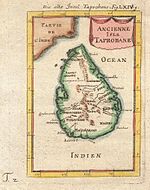Dīpavaṃsa
| Part ofa serieson |
| Theravāda Buddhism |
|---|
 |
| Dīpavaṃsa | |
|---|---|
| Type | Post-canonical text;Vaṃsa |
| Composition | 3rd-4th Century CE |
| Attribution | Anonymous |
| PTSAbbreviation | Dīp |
| Pāli literature | |
| History of Sri Lanka | ||||||||||||||||
|---|---|---|---|---|---|---|---|---|---|---|---|---|---|---|---|---|
 | ||||||||||||||||
| Chronicles | ||||||||||||||||
| Periods | ||||||||||||||||
|
||||||||||||||||
| By Topic | ||||||||||||||||
TheDīpavaṃsa[1](Sanskrit:दीपवंस,Pali:[diːpɐˈʋɐ̃sɐ],"Chronicle of the Island" ) is the oldest historical record ofSri Lanka.The chronicle is believed to be compiled fromAtthakathaand other sources around the 3rd to 4th century CE. Together with theMahāvaṃsa,it is the source of many accounts of the ancient history of Sri Lanka and India. Its importance resides not only as a source of history and legend but also as an important early work inBuddhistand Pali literature.
Contents[edit]
It is probably authored by several Buddhist monks or nuns of theAnuradhapura Maha Viharayain the 3rd-4th century. TheDipavamsawas likely the first completely new Pali text composed in Sri Lanka; it was also among the last texts to be composed anonymously.[2][3]
The preamble begins with "Listen! I shall relate the chronicle of the Buddha's visits to the island, the arrival of theTooth Relicand theBodhi tree,the advent of the Buddha's doctrine, the rise of the teachers, the spread of Buddhism in the island and the coming ofVijayathe Chief of Men ".[4]Dhatusena of Anuradhapura(5th century) had ordered theDipavamsabe recited at theMahindafestival held annually inAnuradhapura.
The Dipavamsa refers to three visits to the Island by the Buddha, the places beingKelaniya,Deegavapi Raja Maha Viharaya,the place where the Bo-sapling was later planted within the Maha Mewna-uyana (Park) of Anuradhapura. It does not make any mention of the Buddha visitingSri Pada.
Depiction of Buddhist sects[edit]
Starting with theDīpavaṃsain the 4th century, the Theravādins of the Mahāvihāra in Sri Lanka attempted to identify themselves with the originalSthavira sectofIndia.TheDīpavaṃsalauds the Theravāda as a "greatbanyan tree,"and dismissively portrays the otherearly Buddhist schoolsas thorns (kaṇṭaka).[5]
- These 17 sects are schismatic,
- only one is non-schismatic.
- With the non-schismatic sect,
- there are eighteen in all.
- Like a great banyan tree,
- the Theravāda is supreme,
- The Dispensation of the Conqueror,
- complete, without lack or excess.
- The other sects arose
- like thorns on the tree.
- —Dīpavaṃsa,4.90–91[6]
Relationship to theMahavamsa[edit]
Regarding the Vijaya legend, Dipavamsa has tried to be less super-natural than the later work,Mahavamsa,in referring to the husband of theKalingaprincess, ancestor of Vijaya, as a man named Sinha who was an outlaw that attacked caravans en route. In the meantime, Sinha-bahu and Sinhasivali, as king and queen of the kingdom of Lala (Lata), "gave birth to twin sons, sixteen times." The eldest was Vijaya and the second was Sumitta. As Vijaya was of cruel and unseemly conduct, the enraged people requested the king to kill his son. But the king caused him and his seven hundred followers to leave the kingdom, and they landed in Sri Lanka, at a place called Tamba-panni, on the exact day when the Buddha passed into Maha Parinibbana.
The Dipavamsa gives a fuller account of the arrival of TheriSangamitta(daughter to Asoka), but the epic story ofDutugamunuis treated only briefly, in ten Pali stanzas, while the Mahavamsa devoted ten chapters to it. Due to the greater attention given to the nuns of Sri Lanka in the Dipavamsa, as well as the description of Sangamitta as being particularly proficient in history,Hugh Nevillsuggested that the Dipavamsa might have originated with the nuns' community at one or more of the Viharas, rather than being composed by monks.[3]
The Dipavamsa is considered "source material" to the Mahavamsa. The latter is more coherently organized and is probably the greatest religious and historical epic in thePalilanguage. The historiography (i.e., the chronology of kings, battles etc.) given in the Mahavamsa, and to that extent in the Dipavasma, are believed to be largely correct from about the time of the death ofAshoka.[7][8]
Editions, Translations and Studies[edit]
TheDīpavaṃsawas edited and translated into English by Hermann Oldenberg in 1879.[9]Subsequently, the text was studied by B. C. Law in 1947.[10]Tilman Frasch has shown that a longer and less corrupt version of the text was maintained in Burma compared to the Sinhalese manuscripts used by Oldenberg for his edition. One such manuscript is in theJohn Rylands Library.[11]
See also[edit]
References[edit]
- ^Also transcribedDeepavamsa.
- ^Von Hinüber, Oskar(1997).A Handbook of Pali Literature(1st Indian ed.). New Delhi: Munishiram Manoharlal Publishers Pvt. Ltd.ISBN81-215-0778-2.
- ^abMalalasekera, G.P.(1928).The Pali Literature of Ceylon(1998 ed.). Colombo: Buddhist Publication Society of Sri Lanka. pp. 132–36.ISBN9552401887.
- ^Differences between the Dipavamsa and the Mahavamsa.
- ^Morgan, Diane.Essential Buddhism: A Comprehensive Guide to Belief and Practice.2010. p. 113
- ^Sujato, Bhante(2012),Sects & Sectarianism: The Origins of Buddhist Schools,Santipada, p. i,ISBN9781921842085
- ^[1]See Geiger's defence of the historicity of the Mahavamsa
- ^K. M. de Silva,History of Sri Lanka(Penguin) 1995
- ^“The Dîpavaṃsa; an ancient Buddhist historical record”,edited and translated by Hermann Oldenberg. London,Williams and Norgate,1879.
- ^Law, B. C. (1947).On the Chronicles of Ceylon.Royal Asiatic Society of Bengal.
- ^Tilman Frasch, "Notes on Dipavamsa: An Early Publication by U Pe Maung Tin," The Journal of Burmese Studies 9 (2004): 70-81. Online at:https://doi.org/10.5281/zenodo.5636717

